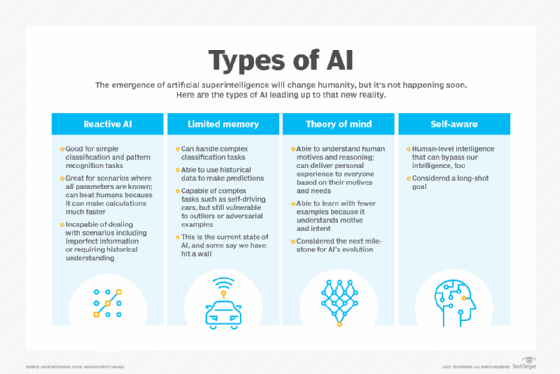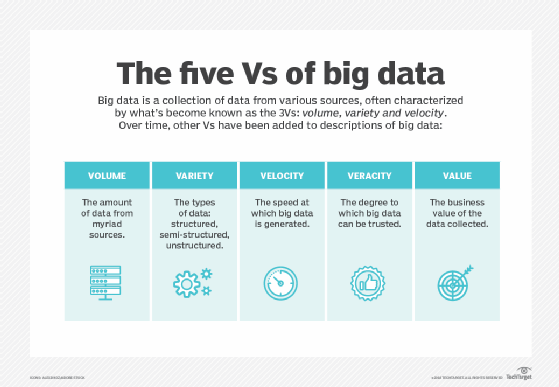Big data vs. artificial intelligence: How they compare
Artificial intelligence can help synthesize and analyze the large volumes of information provided by big data initiatives. The two are different, but they work well together.
Comparing big data and artificial intelligence is like choosing between a shovel and a pick. Although the two complement each other in important ways, they're distinctively different in both nature and purpose.
Big data refers to large volumes of diverse and dynamic data that can be mined for information. AI is a set of technologies that enables machines to simulate human intelligence. AI requires the volumes of big data to effectively learn and evolve. Big data relies on AI to more intelligently mine for information.
The discussion is less about big data vs. artificial intelligence and more about big data and AI combined. They're both powerful technologies in their own rights, but together, the possibilities are unlimited.
What is big data?
Big data not only describes large sets of data, but it's also encompasses data that can be extremely varied, moves at a high velocity and has meaning within a defined context. The goal of using big data is data transformation and analytics that lead to specific results.
For example, data produced by social networks or the internet of things (IoT) by itself isn't enough to qualify as big data in the strictest sense. The data must also be part of a larger analytics strategy that can lead to process automation, enhanced decision-making or other specific results.
Big data can include structured, semistructured and unstructured data. It can originate from any data source capable of generating large volumes of data, including:
- social media
- IoT devices
- websites
- log files
- text files
- spreadsheets
- databases
- machinery sensors
From these data sets, organizations can derive valuable insights into their customers and operations in order to make more informed decisions that lead to strategic advantages in how they operate and do business.
What is AI?
When comparing big data vs. artificial intelligence, AI is a much different phenomenon. It refers to a type of intelligence that makes it possible for a machine to perform cognitive functions like those attributed to humans. A traditional system without AI reacts according to how it's been programmed to act; the AI-enabled machine can analyze and interpret data and then problem-solve based on those interpretations. It's always learning from the data, evolving as the data evolves and reacting to what it learns. In this way, the AI system is constantly improving and adjusting its behavior to accommodate change.

AI is made up of a broad set of technologies that each provide different methodologies for analyzing data and learning from that analysis. AI technologies are considered subdisciplines of AI or other AI technologies, but they all fall under the AI umbrella. The following categories are four of the most well-known AI technologies:
- Machine learning is an AI subdiscipline that enables computers to learn from the collected data and then apply that knowledge without human intervention.
- Deep learning is a subdiscipline of machine learning that enables computers to more closely simulate the analytical capabilities of the human brain to achieve increasingly greater accuracy.
- Natural language processing is an AI subdiscipline that enables a machine to analyze, understand and generate human language and approximate natural conversation.
- Computer vision is an AI subdiscipline that enables a machine to recognize and classify images, such as human faces, and then respond to what it sees.
AI is now being used in a variety of ways to enhance technology and drive innovation. AI technology supports everything from robotics to stock trading to medical imaging and personal assistants.
How AI and big data work together
The bottom line in the big data vs. artificial intelligence comparison is that big data refers to the data itself, while AI describes a machine's ability to use big data when learning to act like a human. They are complementary technologies, able to work together in important ways.
AI thrives on data. The greater the amount of data, the more effectively an AI system can analyze, learn and evolve. It's only through big data that AI can realize its fullest potential.
In the past, AI made relatively little progress in becoming useful in a practical sense. AI's slow development was, in part, because of the lack of technologies able to handle massive data sets. But the proliferation of the internet and the influx of unprecedented amount of information have forced these technologies to evolve, particularly when it comes to storage. These advancements enable AI to ingest more data and, as a result, conduct more accurate and thorough data analytics. And as these technologies continue to improve, AI will only become more powerful, accurate and comprehensive.
At the same time, AI promises to enhance big data so it can derive greater meaning from the data through more advanced analytics. Until recently, the characteristics that defined big data -- volume, velocity and variety -- quickly overwhelmed the capabilities of traditional analytics. AI, however, can help find significant trends and patterns in big data that might otherwise be misinterpreted or go undiscovered. In the same way that AI needs big data, big data needs AI to reach its fullest potential.

How storage technologies support AI and big data
The advancements in storage and data management technologies are what make today's AI and big data offerings possible. Today's solid-state flash arrays can handle greater capacities and support faster I/O operations than ever. Although AI doesn't warrant these capacity and performance levels, its hunger for large data sets does, creating a symbiotic relationship between AI and big data realized, in large part, through modern storage technologies.
The latest generation of SSDs can deliver greater IOPS and throughput at much lower latencies than could be achieved only a few years ago. Some enterprise SSD arrays can now deliver throughputs of 100 GBps and even much higher, with latency falling to well below 1 millisecond. At the same, they can deliver petabyte-scale capacity without compromising performance.
One reason for the greater capabilities is NVMe-oF, a storage communications standard that offers speeds comparable to DAS but over network connections. In this way, organizations can set up flexible, shared storage that can more effectively handle AI and big data workloads. In addition, new technologies such as storage class memory promise to continue to break performance barriers to better accommodate AI and big data going forward.
With the improvement in storage technologies, large data sets have become more available and manageable, making it possible for AI to also evolve. In fact, big data might turn out to be the greatest single influence on AI's imminent rise. Although there is a significant difference between big data and artificial intelligence, the two go hand in hand, and the relationship between them will only continue to grow and intensify.








